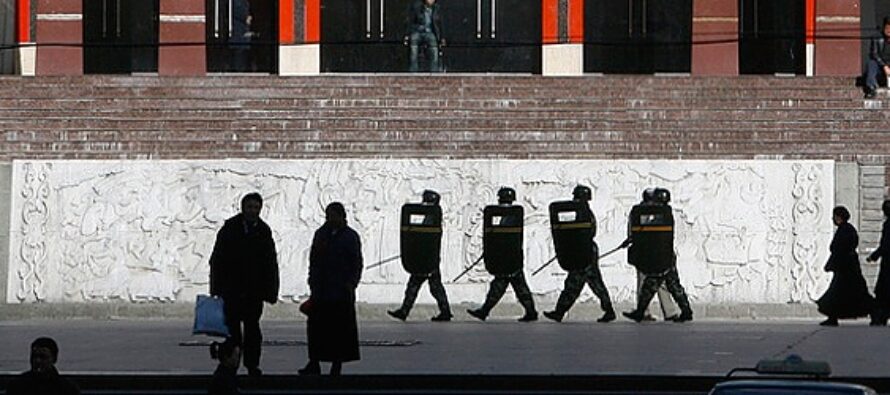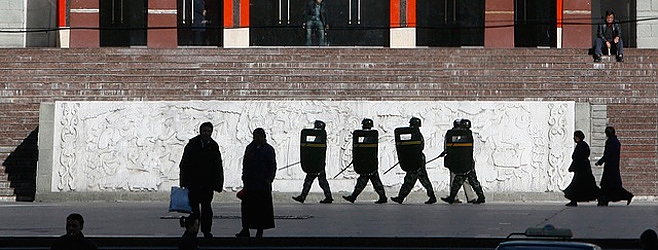China: Witnesses Lift Veil on Abuses by Security Forces in Tibet

![]()

(New York) – Eyewitness accounts confirm that Chinese security forces used disproportionate force and acted with deliberate brutality during and after unprecedented Tibetan protests beginning on March 10, 2008, Human Rights Watch said in a new report released today. Many violations continue today, including disappearances, wrongful convictions and imprisonment, persecution of families, and the targeting of Tibetans suspected of sympathizing with the protest movement.
The 73-page report, “‘I Saw It with My Own Eyes’: Abuses by Security Forces in Tibet, 2008-2010,” is based on more than 200 interviews with Tibetan refugees and visitors conducted immediately after they left China, as well as fresh, not previously reported, official Chinese sources. The report details, through eyewitness testimonies, a broad range of abuses committed by security forces both during and after protest incidents, including using disproportionate force in breaking up protests, proceeding to large-scale arbitrary arrests, brutalizing detainees, and torturing suspects in custody.
“Dozens of eyewitness testimonies and the government’s own sources show clearly the official willingness to use lethal force against unarmed protestors,” said Sophie Richardson, Asia advocacy director at Human Rights Watch. “This report decisively refutes the Chinese government’s claim that it handled the protests in line with international standards and domestic laws.”
The report also suggests that contrary to government claims, Chinese security forces opened fire indiscriminately on demonstrators in at least four separate incidents, including in one area of downtown Lhasa on March 14.
In order to avoid external or independent scrutiny of the security operations, the Chinese authorities effectively locked down the entire Tibetan plateau and dispatched massive numbers of troops across all Tibetan-inhabited areas. It expelled journalists and foreign observers, restricted travel to and within the region, cut or monitored telecommunications and internet, and arrested anyone suspected of reporting on the crackdown. The government has rejected all calls for independent investigations into the protests, including those from the United Nations High Commissioner for Human Rights and UN special rapporteurs.
Human Rights Watch has condemned violence committed by Tibetans as well as by security forces. In Lhasa alone, 21 people were killed and several hundred injured during the March 14-15 time period in 2008, according to government figures. But international legal standards limit the use of force by states to that which is strictly necessary in order to protect life or to apprehend perpetrators of violent crimes. In multiple incidents, eyewitness testimonies show that Chinese forces acted in contravention of these standards and broke international law – including prohibitions against disproportionate use of force, torture, and arbitrary detention, as well as the right to peaceful assembly – despite government claims to the contrary.
From the outset of the protests, the Chinese government consistently stated that it would handle all cases arising from the protests in an impartial manner and “according to law.” But the report offers a very difference picture: one in which thousands of demonstrators and ordinary Tibetans were arrested and detained without due process and without regard to legal procedures; where the state provided no accountability as to the whereabouts of detainees; and where a politicized judiciary controlled by party authorities conducted proceedings in which defendants had virtually no due process.
Human Rights Watch said that the report’s finding showed that the Chinese government urgently needs to investigate the protests and their aftermath, and open the region to media and international monitors. The Chinese authorities also need to examine the conduct of its security forces, which eyewitnesses consistently say used disproportionate force; deliberately brutalized and mistreated Tibetans detained for suspected involvement in the unrest; and deprived detainees of minimum guarantees of due process of law, including formal notification of where, or why, they were held.
“The need for an international investigation into the situation in Tibet is a great as ever,” Richardson said. “Abuses by security forces are unlikely to quell, and may even aggravate, the longstanding grievances that prompted the protests in the first place.”
Background
In early March 2008, the suppression by Chinese security forces of a string of peaceful protests by Tibetan monks from major monasteries in and around Lhasa led to a severe break down of public order in the capital of the Tibet Autonomous Region of China on March 14.
As massive security reinforcements from neighboring provinces poured into the area and the government threatened a major crackdown, an unprecedented wave of protests erupted across the Tibetan plateau. Official reports acknowledged over 150 incidents in the first two weeks, and occasional isolated protests continued to be reported over many months.
In response this most sustained episode of Tibetan unrest in decades, the Chinese government launched largest security operations in the country since the crackdown of the Tiananmen movement in 1989.
Yet the Chinese government has yet to explain the precise circumstances that led to dozens of clashes between protesters and police. It has not addressed how its security forces handled protesters – including allegedly using lethal force and abandoning Lhasa’s city-center to protesters and looters for several hours on March 14. Nor has the Chinese government revealed the fate of hundreds of Tibetans arrested during the protests, or disclosed how many Tibetans have been detained, sentenced, held pending trial, or sentenced to extrajudicial forms of detention.
Testimonies from “‘I Saw It with My Own Eyes’: Abuses by Security Forces in Tibet, 2008-2010”:
“They were firing straight at people. They were coming from the direction of Jiangsu Lu firing at any Tibetans they saw, and many people had been killed.”
– Pema Lhakyi (not her real name,) a 24-year -old Lhasa resident.
“She was shot by a single bullet in the head. Local people managed to take her body home to the village, which is about five kilometers from Tongkor monastery.”
– Sonam Tenzin (not his real name), a 27-year-old monk from Tongkor monastery.
“At first, the soldiers fired in front of the crowd a few times to scare them, but the crowd thought they would not dare to actually fire and continued crowding inside the compound. At that point, the soldiers started to fire.”
– Tenpa Trinle (not his real name), a 26-year-old monk from Seda county.
“The first thing I saw was a lot of soldiers and police beating the crowd with electric batons. Groups of four or five soldiers were arresting crowd members one by one and putting them in a truck.”
– Dorje Tso (not his real name) 55-year-old resident from Tongren.
“They burst in, breaking the doors and gates of the colleges and dormitories. The soldiers were armed and equipped with hatchets and hammers, as well as torches, handcuffs and wire ropes. On entering monks’ rooms they would first ask for phones, which were systematically confiscated … Some of the arrested monks were handcuffed; others tied up with wire ropes … They ordered us to move very fast, and if we didn’t, they’d hit us. Several hundred monks were taken away.”
– Jampa Lhaga (not his real name), a former Drepung monk in Lhasa.
“None of the means … adopted there have exceeded the constitutional rights of the armed forces or international law.”
– Wu Shuangzhan, Commander of the People’s Armed Police, March 16, 2008.
“We were beaten very badly. The guards used clubs and sticks to beat us … They hit us mostly on the lower body. This lasted two days. Then we were taken to Gutsa prison in Lhasa. There, the police interrogated us non-stop for two whole days and nights. They were beating us, taking turns to conduct the interrogation …”
– Rinchen Namgyal (not his real name), a 33-year-old monk from Ganden monastery.
“Up to 30 people were crowded in cells of three or four square meters. There was no space to sit down so detainees had to stand most of the day and night. The cells had no toilets but prisoners were not taken out and had to relieve themselves in the cell. They were given one bowl of rice congee a day. Many were subjected to beatings.”
– Pasang Choepel (not his real name), a former detainee from Aba.
“The Ganzi Tibetan Autonomous Prefecture Intermediate People’s Court held that the defendant Dorje Kandrup [Ch. Duoji Kangzhu] wrote pamphlets calling for Tibetan independence, threw them on important roads of Ganzi County, brazenly inciting to split the country and destroy national unity, and that her actions amounted to the crime of inciting separatism.
– Public notice of Ganzi prefecture’s Political and Legal Committee announcing the 6-year imprisonment verdict of Dorje Kandrup.
“The beatings continued in the courtyard. The PAP soldiers were using belts and the butt of their guns … They were kicking him on the ground, and he was bleeding a lot-there was so much blood. Then they left him just lying on the ground, motionless … I saw it with my own eyes.”
– Lhundrup Dorje (not his real name), a resident from Lhasa.
Related Articles
Domestic violence victims’ cries for help not heard
![]()
YONCA POYRAZ DO?AN ?STANBUL Tu?ba Özbek, a 38-year-old mother of an 11-year-old boy in ?stanbul, knew the address of the
Greece must stop treating migrants as criminals Greece must stop treating migrants as criminals
![]()
Unaccompanied children are often held with adults, which is illegal under international law.© UNHCR/L. Boldrini The Greek authorities should immediately
UNITED STATES HEALTHCARE: “My health care shouldn’t be a market!”
![]()
The battle over the necessity to have healthcare is a flashpoint now



